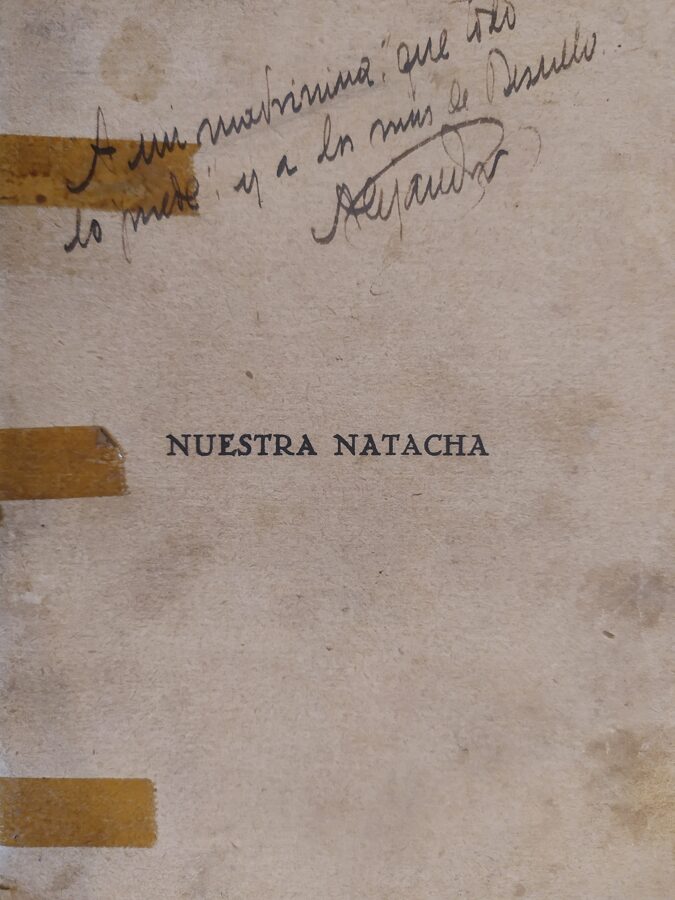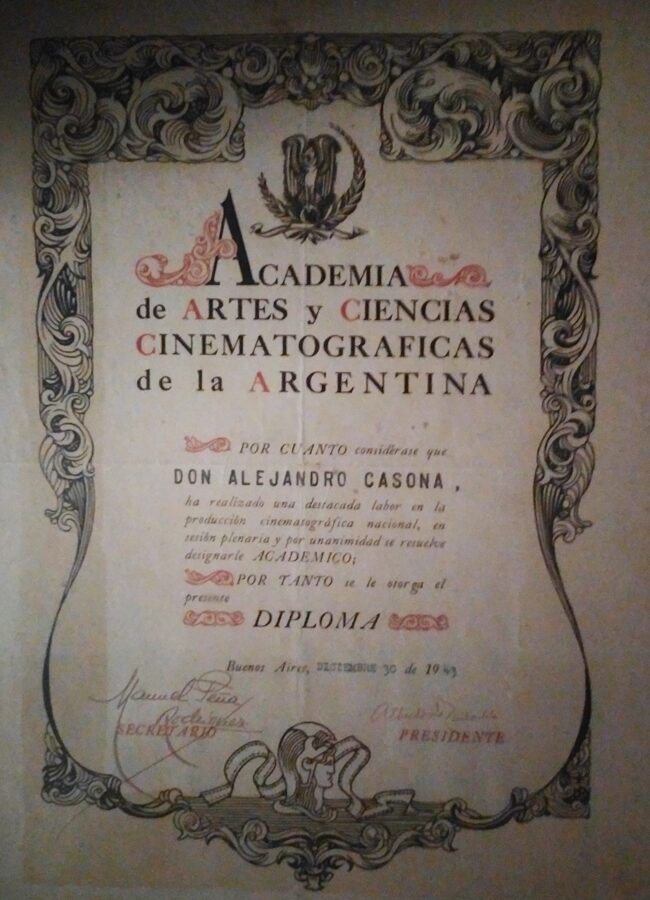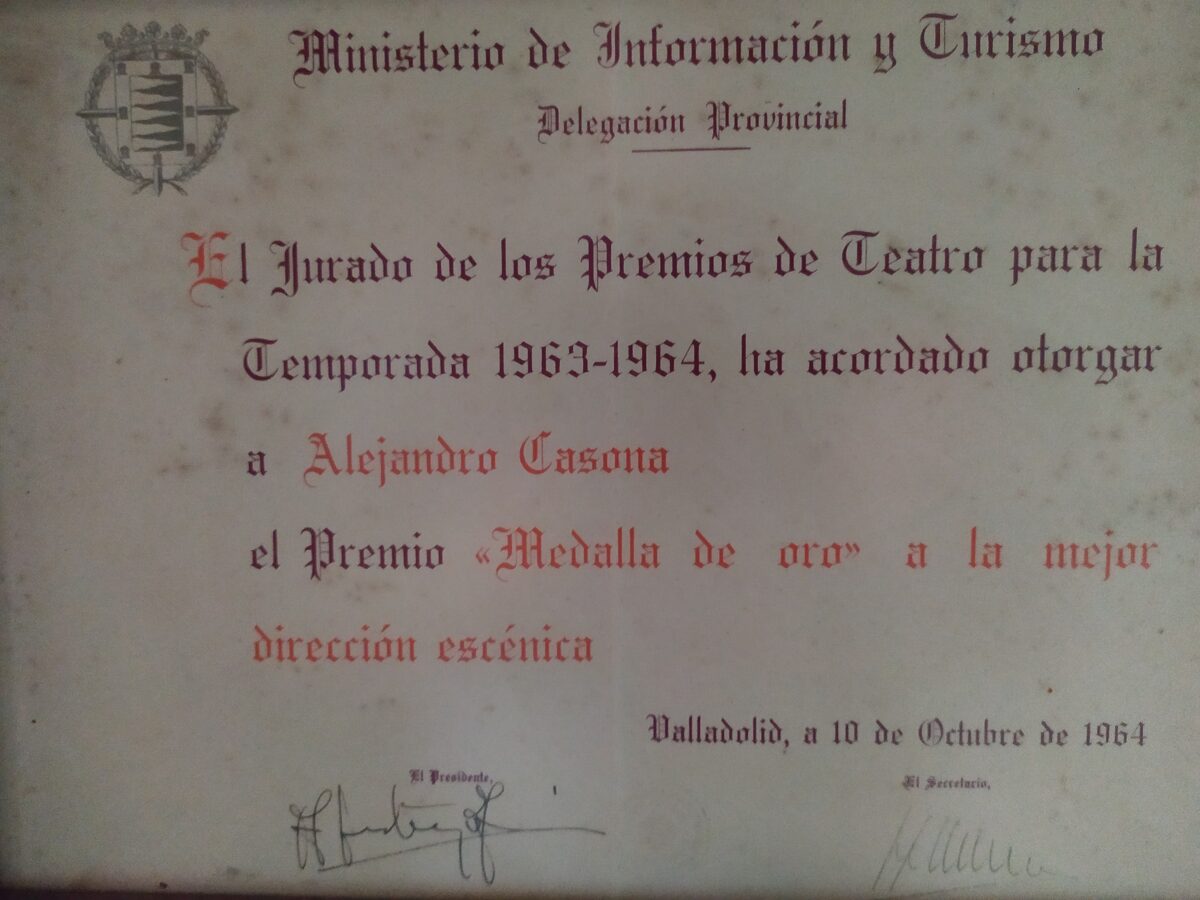Casona, from Besullo to the World

Illustration by Goico Aguirre depicting Casona
Alejandro Rodríguez Álvarez was born in Besullo (Cangas del Narcea) on March 23, 1903. In this town in the southwest of Asturias, where his father was from, he lived the first five years of his life with his parents Gabino Rodríguez and Faustina Álvarez, at that time assigned there to be in charge of the schools for boys and girls.
The nomadic life of teachers in Spain at the beginning of the 20th century meant that soon their marriage had to separate temporarily, when Faustina was sent to Barcia (Luarca), while Gabino undertook a trip to Villaviciosa. Alejandro would accompany his father there, and then to Gijón, where he would begin his high school studies.

Bachelor's degree from Alejandro Casona issued in Murcia on August 24, 1924
Palencia (where he would achieve his first literary recognition by winning the Natural Flower in the Floral Games of Zamora at barely 11 years old with "La empresa del Ave Maria") and Murcia would be his next stops, the latter being where he would continue his training obtain his bachelor's degree.

Title of First Teaching Teacher, issued on March 23, 1926
From there he would jump to Madrid, studying at the Escuela Normal de Magisterio, and obtaining the title of teacher of first normal education, section of letters in 1929 (curiously given the day of his 26th birthday). In the capital he would publish his first book, "El peregrino de la barba florida", by the hand of his friend Alfonso Hernández-Catá, director of the Mundo Latino publishing house.
A year earlier, he had married a fellow student, Rosalía Martín Bravo. With her he would travel to the lands of the Arán valley to take charge of the Lés school, where he would remain until his transfer to Oviedo in February 1931. His only daughter, Marta Isabel, was born in Lés in 1930, around the same time his book of poems "La flauta del sapo" was self-published, first published use of the pseudonym Alejandro Casona. His mark would remain in the founding of a theater company for children called "La pájara pinta" and in the creation of a printing press in which the students themselves published their articles.

Premiere of "The Crime of Lord Arthur" in Zaragoza (1929), Colección Luis Miguel Rodríguez
During that period, Casona adapted Oscar Wilde's "El crímen de Lord Arturo", which would be released in 1929 in Zaragoza by the Rafael Rivelles and María Fernanda Ladrón de Guevara company, and in which the pseudonym Casona appeared on the bill for the first time ( in honor of the "casona del maestro" of his hometown, Besullo).

Having returned to Madrid, and now with the title of teaching inspector (the position his mother Faustina and his sister Teresa had already achieved), he would take charge of the People's Theater commissioned by Manuel Bartolomé Cossío, president of the Board of the Pedagogical Missions created under the auspices of the Spanish Republic. With this group he would travel a large part of deep Spain between 1932 and 1935, adapting short pieces of Spanish classical theater (which would compose "Retablo Jovial") and works of universal literature, aimed at both adults and children and young people. Following this line, he would obtain the Premio Nacional de Literatura for "Flor de leyendas", a set of fourteen stories in which he collects myths and legends from the most diverse written traditions (Indian, Arabic, Greek, German, Scandinavian, etc.) with the intention of bringing them closer to the younger audience.
Premiere of "La sirena varada" at Teatro Español (1934)
In 1934 he received the Lope de Vega award for "La sirena varada", premiered at the Spanish Theater on the night of March 17, by the Margarita Xirgu y Borrás Company, constituting a resounding success.

1935 was another year of glory, with the first performance of "Nuestra Natacha" in Barcelona, which would be followed on April 25 by "Otra vez el Diablo" at the Spanish Theater in Madrid, "The mystery of María Celeste" (written in collaboration with A. Hernández Catá), in Valencia and again in Madrid "El mancebo que casó con mujer brava".
Already in 1936 "Nuestra Natacha" was premiered in Madrid. His groundbreaking pedagogical and social approach collided head-on with predominant ideals which up to that moment had put Casona in the crosshairs of the most conservative sectors of Spanish society, already absolutely convulsed.
Now one of the most praised authors of republican Spain, this upward trajectory would be nipped in the bud by the outbreak of war. Helped by friends and colleagues, an improvised escape route took him from León to Besullo. There he heard the radio redention of "Nuestra Natacha" on the radio, interrupted by exalted multiple times. Warned by several neighbors of the risk he was running, he decided to set out on his way through the mountains towards Gijón and from there to Santander, San Sebastián and Irún. Later he passed to France, where contacted the Josefina Díaz de Artigas and Manuel Collado comedy company.
As its artistic director, he began a tour of America: the company visited Mexico, Cuba, Puerto Rico, Venezuela, Colombia, Peru, Chile and Argentina from 1937 to 1939. Simultaneously he dedicated himself to giving numerous lectures at a multitude of conferences and institutions, and was awarded by different entities. In Mexico he premiered in 1937 "Prohibido suicidarse en primavera" and in Caracas "Romance en tres noches" in 1938.
In July 1939 he established his residence in Buenos Aires, where he continued to write and collaborate with various publications and came into contact with film and radio, adapting scripts for both media. He also had time to travel, both in America and Europe, attending performances of his works.
His time in Argentine would be characterized by a feverish creative trajectory: "Sinfonía inacabada" in Montevideo and "Pinocho y la Infantina Blancaflor" in Buenos Aires in 1940 and "Las tres perfectas casadas" in Buenos Aires in 1941 would give way to the premiere on November 3 from 1944 of "La dama del alba" at the Avenida Theater by Margarita Xirgu's company.
Buenos Aires would also be the setting for them to see the light of "La barca sin pescador" (1945), "La molinera de Arcos" (1945) and "Sancho Panza en la Insula" (1947). In 1949 came "Los árboles mueren de pie", represented for three consecutive seasons on the same Buenos Aires stage and on another Parisian one.
The new decade would begin with "La llave en el desván" in Buenos Aires and "A Belén pastores" in Montevideo in 1951. "Siete gritos en el mar" in 1952, "La tercera palabra" in 1953, "Corona de amor y muerte" in 1955 would be the preamble to "La casa de los siete balcones", which raised the curtain for the first time in 1957, and which is considered by experts as one of his masterpieces.
"Carta de una desconocida" in Porto Alegre in 1957, theatrical adaptation of Stefan Zweig's novel," Tres diamantes y una mujer" in Buenos Aires in 1961 and "Carta de amor de una monja portuguesa", also in Buenos Aires in 1962 would mark the end of his American era.

At the same time, Casona developed a long career as a film scriptwriter: "Veinte años y una noche" in 1941, "En el viejo Buenos Aires", "Concierto de almas", "Su primer baile" y "La maestrita de los obreros" in 1942, "Casa de muñecas" by Ibsen y "Cuando florezca el naranjo" in 1943, "La pródiga" y "Le fruit mordu" in 1945, "Milagro de amor", "Margarita la tornera" y "El abuelo" by Galdós in 1946, "El que recibe las bofetadas" in 1947, "El extraño caso de la mujer asesinada" in 1949, "No abras nunca esa puerta" y "Si muero antes de despertar" in 1952, "Un ángel sin pudor" in 1953, "Siete gritos en el mar" in 1954 y "La cigüeña dijo ¡Sí!" in 1955. His works as a film author were: "Ceniza al viento" in 1942, "Nuestra Natacha" in 1944, "María Celeste" in 1945, "La barca sin pescador" y "Romance en tres noches" in 1950 y "Los árboles mueren de pie" in 1951.

Casona on his return to Asturias, accompanied by her nephew Luis Miguel Rodríguez (Colección Luis Miguel Rodríguez)
Casona officially returned to Spain in 1962. He witnessed the premiere in Madrid of "La dama del alba" on April 22 at the Teatro Bellas Artes, which was received by the public with unanimous enthusiasm, which was repeated with the rest of his "american" works. That public success collided with the rejection of the playwrights and literary critics of social realism, which lacked cultural relevance and was detached from historical circumstance.

Gold Medal for Best Stage Direction at the 1963-1964 Theatre Awards of the Season
The only play that Alejandro Casona wrote after his return from Argentina was "El caballero de las espuelas de oro", a historical drama about Francisco de Quevedo, premiered in Puertollano in 1964 and later at the Teatro Bellas Artes in Madrid on the night of October 1, 1964, by the José Tamayo company, with musical accompaniment by Cristóbal Halffter.

Image of Alejandro Casona on his return to Spain
In 1965, with heart problems, he underwent a surgical operation to try to solve them. In principle, the prognosis was favorable to his recovery, or at least as reflected in the letter given and addressed to his relatives in Besullo on 25 August of that year. However, barely a month later, on September 17, Casona would die in Madrid.